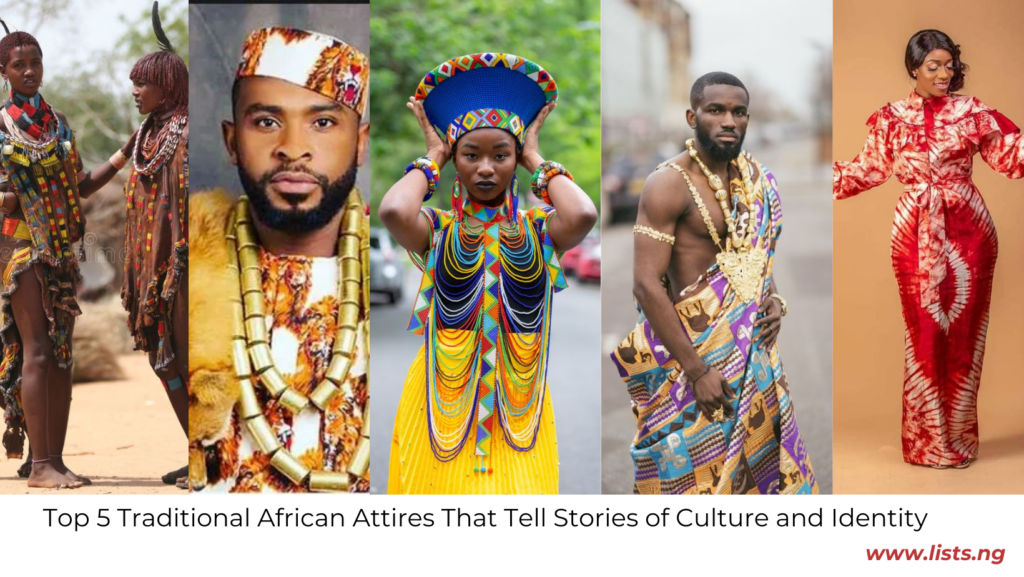African fashion is dynamic and diverse, embodying the continent’s rich cultural past. African fashion wear is a true representation of the continent’s creativity and style. African attire is an important part of the continent’s fashion scene. From Ghana’s colourful kente cloth to Nigeria’s beautiful adire, each country has its own traditional dress that tells stories of culture and identity. These attires are not only gorgeous but are of great cultural importance, frequently symbolizing status, spirituality, and community.
In today’s blog post, we’ll be discussing top five (5) different African attires and their beauty.
- Adire (Nigeria)
Adire is a traditional Yoruba textile art form from Nigeria that features elaborate tie-dye designs on fabric. “Adire” means “tie and dye” in Yoruba. It is a resist-dyeing technique in which portions of the cloth are tied or wrapped to resist the dye, resulting in distinctive and beautiful designs. Adire has a rich and long history in the Yoruba tradition. It was mostly worn by royalty in the days of our forefathers and represented authority and prestige. The art form was passed down through generations of Yoruba mothers who went on to teach their children. The process of making adire is very tedious and involves repeated actions of designing, tying, dyeing, and rinsing.
The Adire fabrics are culturally, socially, and spiritually significant. They are worn at ceremonies, festivals, and significant life events. Today, Adire has grown, adopting present-day techniques and materials while retaining its historic identity.
- Kente Cloth (Ghana)
The Kente cloth is a colourful woven fabric that originated with Ghana’s Ashanti people. It is a symbol of cultural history, identity, and pride that is worn on special occasions and utilized in traditional ceremonies like weddings. The Kente cloth has different cloth patterns and specific meanings. This includes colours that represent values like gold (royalty), blue (peace), and red (blood), and symbols that represent concepts like wisdom, strength, and community.
Kente traces back over 400 years to the Ashanti Kingdom, a powerful empire in present-day Ghana. According to tradition, a spider named Anansi taught the Ashanti how to weave Kente cloth. The cloth was once worn by royalty and nobles, but its importance goes beyond social class. Making the Kente cloth is a time-consuming and skill-intensive process. It involves cotton production, dyeing, warping, weaving, and pattern creation.
- Himba Attire (Northern Namibia)
The Himba attire refers to the traditional clothing and adornments worn by the Himba people, an indigenous tribe living in northern Namibia. The attire is worn with intricate hairstyles, jewellery, and clothing made from animal hide, fabric, and natural materials. The attire holds significant cultural and spiritual value, representing spiritual connection, beauty, strength, and cultural identity. Himba attire reflects the tribe’s history, traditions, and connection to nature.
The Himba people believe that their apparel allows them to interact with their ancestors and the spiritual realm. The complex hairstyles and adornments represent beauty, strength, and social standing.
- Zulu Attire (South Africa)
Zulu attire is traditional clothing worn by the Zulu people, the largest ethnic group in South Africa. Zulu attire has a long history, dating back to the 18th century. The attire was originally worn for ceremonial purposes, such as weddings, coronations, and battles. The bold colors and intricate patterns symbolize the Zulu people’s bravery, strength, and cultural identity. Traditionally, it was made of animal skins, beads, and cloth, each with its own symbolic meaning.
Colonization and modern influences brought new materials, but the Zulu have conserved their traditions, modifying rather than replacing the sartorial conventions that represent an important thread in the fabric of their past. The process of making Zulu attire includes material selection, dyeing, pattern creation, sewing, and adding accessories.
- Ishiagu (Nigeria)
Ishiagu is a traditional Igbo attire originating from the southeastern region of Nigeria. It is a vibrant and iconic fabric featuring intricate designs and patterns on a blue or red background. Ishiagu, translating to “Lion head” in English, features patterns resembling the spots on a leopard’s head. It symbolizes strength, courage, and nobility. Ishiagu was initially linked with titled men and used as a wealth indicator. It has gradually gained popularity among young people and is no longer exclusive to the elite.
This Igbo attire hasn’t been forgotten; instead, in this modern day, it is worn on both traditional and modern occasions, including cultural festivals and events, weddings and celebrations, formal gatherings and meetings, and as fashion statements and expressions.
Wrapping Up,
Traditional African clothing beautifully reflects culture and identity, each piece with its own story. From Kente cloth to Adire, these garments keep traditions alive and link different generations. By appreciating these attires, we honor African artistry and heritage, celebrating their lasting beauty and importance in both past and present fashion.



